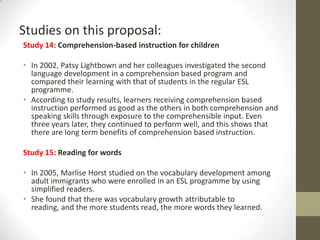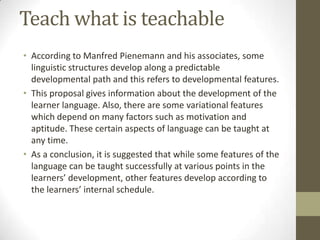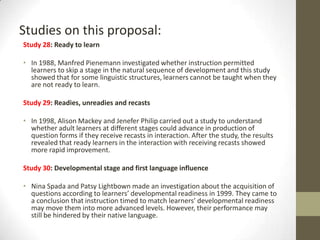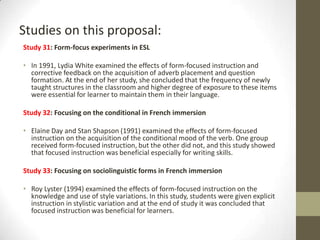Second Language Learning in the Classroom
- 1. Chapter 6: Second Language Learning in the Classroom
- 2. Six proposals for classroom teaching • 1 Get it right from the beginning • 2 Just listen ... and read • 3 Let's talk • 4 Two for one • 5 Teach what is teachable • 6 Get it right in the end
- 3. Get it right from the beginning • In this proposal, there is a focus on structure based instruction and it is given emphasis to form and accuracy. • In its origin, there are grammar translation and audio-lingual approaches. • According to this proposal, free language use is not allowed because students can make mistakes and if they repeat these mistakes, they can be habits or get fossilized. Therefore, teachers should give corrective feedback to the students. • However, the supporters of more communicative approaches argue this view and they suggest that errors are natural for learning and it is better to encourage learners to develop fluency before accuracy, but allowing learners too much freedom without correction and explicit instruction is a negative side of this view.
- 4. Studies on this proposal: Study 12: Audio-lingual pattern drill • In the late 1970s, Patsy Lightbown carried out an experiment to investigate the effect of audio-lingual instruction on interlanguage development. At the end of this research, it is understood that exclusive focus on accuracy and practice of form doesn’t mean that learners will use the forms correctly. It does not guarantee lasting accuracy and knowledge of forms. Study 13: Grammar plus communicative practice • In 1972, Sandra Savignon studied the linguistic and communicative skills of students. She gave additional language instruction to the each group of students and tested the differences in students’ language development before and after instruction. This study shows that focus only on accuracy and form do not give students opportunity to develop communication abilities.
- 5. Just listen ... and read • This proposal is based on the hypothesis that language acquisition takes place when learners are exposed to comprehensible input through listening and reading. • According to this view, comprehensible input is essential for understanding the meaning. Also it suggests that drills and practices are not necessary to learn a language and learners do not need to speak. • It is enough to hear and understand the target language. Therefore, there are lots of reading and listening activities in this kind of classroom. • We can say that this proposal is inspired from Krashen’s Input Hypothesis.
- 6. Studies on this proposal: Study 14: Comprehension-based instruction for children • In 2002, Patsy Lightbown and her colleagues investigated the second language development in a comprehension based program and compared their learning with that of students in the regular ESL programme. • According to study results, learners receiving comprehension based instruction performed as good as the others in both comprehension and speaking skills through exposure to the comprehensible input. Even three years later, they continued to perform well, and this shows that there are long term benefits of comprehension based instruction. Study 15: Reading for words • In 2005, Marlise Horst studied on the vocabulary development among adult immigrants who were enrolled in an ESL programme by using simplified readers. • She found that there was vocabulary growth attributable to reading, and the more students read, the more words they learned.
- 7. Study 16: Total physical response • In 1972, it was developed by James Usher. In TPR classes, children or adults engage in activities in which they respond physically. Language production is not expected. They listen and demonstrate heir comprehension by their actions. • Unlike Krashen’s view, in TPR instruction the vocabulary and structures are carefully graded and organized. Asher’s research showed us that students can develop advanced levels of comprehension without engaging in oral practice. Study 17: Input flood • Martha Trahey and Lydia White carried out a study with young French-speaking learners to investigate the effects of high frequency exposure to a particular form and use of that form in 1993. Learners were exposed to so many correct instances of that form and failed to notice ungrammatical usage. It can be concluded from the study that there should be explicit information in the lesson about what is not grammatical in second language. .
- 8. Study 18: Enhanced input • Johanna White carried out a study involving enhanced input in 1998. To draw the learner’s attention to the teaching item typographical enhancement was added (bold type, capitalized letters etc. ) and at the end of the study little difference was found between learners who received enhanced input and learners who did not. Study 19: Processing instruction • In 1993, VanPatten and Cadierno investigated the effects of guided exposure to form on language performance among the adult learners of Spanish. In this study, learners’ attention was directed to how language forms were used to express certain meanings (processing instruction). This study showed that learners who received comprehension-based processing instruction performed better in both comprehension and production tasks
- 9. Let's talk • In this proposal, the emphasis is on the meaningful interaction and this proposal supports the interactionism. It gives importance of access to both comprehensible input and conversational interactions with teachers and other students. • According to this view, when learners engage in interaction, they have access to meaningful and comprehensible input and negotiate for meaning to arrive at mutual understanding. Through negotiation, language learners can acquire the language forms more naturally. • As the focus is on the meaning, grammar mistakes can be tolerated. Students can ask and answer genuine questions. • Pair and group work are also important in this view. With the help of this proposal we can create task-based and meaningbased classrooms.
- 10. Studies on this proposal: Study 20: Learners talking to learners • Michael Long and Patricia Porter examined the language produced by adult learners performing a task in pairs in 1985 and they concluded that though learners’ language can not be purely grammatical, they can still benefit from each other as this kind of interaction enables genuine communicative practice. Study 21: Learner language and proficiency level • In 1990, George Yule and Doris Macdonald investigated the effect of the communication roles of the learner on their interactive behavior. To do this, they set up a task and after completing task, they reached a conclusion that teachers should sometimes place more advanced students in less dominant roles in paired activities with lower-level learners.
- 11. Study 22: The dynamics of pair work • Naomi Storch investigated the patterns of pair interaction over time and the effects of different natures of the interactions on language learning in 2002. In her study, she identified four distinct patterns of interaction (collaborative, dominant-dominant, dominant-passive, and expert-novice) and she concluded that when pair work functions collaboratively and learners are in an expert-novice relationship, they can successfully engage in the coconstruction of knowledge. • Study 23: Interaction and second language development • In 1999, Alison Mackey carried out a study among adult learners engaging in different communicative tasks with native speakers of the target language on producing question forms. At the end of the study, learners who interacted with native speakers produced more advanced questions and this result showed that spontaneous natural interaction can be more beneficial for the learners. • Study 24: Learner-learner interaction in a Thai classroom • Kim McDonough investigated the use of pair and small group activities in English as a foreign language classes in 2004. In this study, students engaged in interaction about environmental problems by using conditional types, and they used interactional features such as explicit correction, recast and modified output and this improved their accuracy. However, when she asked whether such activities contributed to learning, she found that students did not perceive pair and group activities as useful for learning.
- 12. Two for one • This proposal refers to Content-based Instruction and it suggests that learners acquire second or foreign language as they study subject matter taught in that language. That is to say, learners get two for one. • They can develop both their academic skills and second language ability. Also, it creates a genuine need to communicate, motivating students to acquire language in order to understand the content.
- 13. Studies on this proposal: Study 25: French immersion programmes in Canada • There are some studies which examine French immersion programmes. Firstly, in 1984, Harley and Swain expressed that although students develop fluency, listening comprehension and confidence in using language, they fail to achieve high levels of performance in some aspects of French grammar. Some researchers argued that this is because of insufficient comprehensible input in these programmes and teacher-centered classes. Also, Elaine Tarone and Merrill Swain noted in 1995 that only classroom exposure was not enough for the language learning and lessons needed to include focus on form and pragmatic features of the language.
- 14. Study 26: Late immersion under stress in Hong Kong • In 1997, Keith Johnson raised concerns about the ability of the educational system to meet the demands for such programmes. He noted that students lacked the necessary proficiency to follow the secondary level curriculum and teachers had difficulty in delivering the content because of limitation in their own language proficiency. Study 27: Inuit children in content-based programmes • Nina Spada and Patsy Lightbown (2002) observed the teaching and learning of school subjects and language with 5-7 aged children. At the end of the observation, they concluded that the students’ lack of age-appropriate academic French is a serious problem.
- 15. Teach what is teachable • According to Manfred Pienemann and his associates, some linguistic structures develop along a predictable developmental path and this refers to developmental features. • This proposal gives information about the development of the learner language. Also, there are some variational features which depend on many factors such as motivation and aptitude. These certain aspects of language can be taught at any time. • As a conclusion, it is suggested that while some features of the language can be taught successfully at various points in the learners’ development, other features develop according to the learners’ internal schedule.
- 16. Studies on this proposal: Study 28: Ready to learn • In 1988, Manfred Pienemann investigated whether instruction permitted learners to skip a stage in the natural sequence of development and this study showed that for some linguistic structures, learners cannot be taught when they are not ready to learn. Study 29: Readies, unreadies and recasts • In 1998, Alison Mackey and Jenefer Philip carried out a study to understand whether adult learners at different stages could advance in production of question forms if they receive recasts in interaction. After the study, the results revealed that ready learners in the interaction with receiving recasts showed more rapid improvement. Study 30: Developmental stage and first language influence • Nina Spada and Patsy Lightbown made an investigation about the acquisition of questions according to learners’ developmental readiness in 1999. They came to a conclusion that instruction timed to match learners’ developmental readiness may move them into more advanced levels. However, their performance may still be hindered by their native language.
- 17. Get it right in the end • This proposal gives importance to form-focused instruction, but this doesn’t mean that everything has to be taught. The emphasis is on the form in communicative framework. It suggests that if learners have enough exposure to language and motivation to learn, they acquire some language features naturally. Also, it is said that focused instruction allows learners to notice the target features in subsequent input and interaction. • In terms of error correction, errors are corrected explicitly. Especially in monolingual classrooms, students make similar mistakes, produce same wrong language and think that these are correct forms. Therefore, explicit focus on form and feedback are necessary in this view.
- 18. Studies on this proposal: Study 31: Form-focus experiments in ESL • In 1991, Lydia White examined the effects of form-focused instruction and corrective feedback on the acquisition of adverb placement and question formation. At the end of her study, she concluded that the frequency of newly taught structures in the classroom and higher degree of exposure to these items were essential for learner to maintain them in their language. Study 32: Focusing on the conditional in French immersion • Elaine Day and Stan Shapson (1991) examined the effects of form-focused instruction on the acquisition of the conditional mood of the verb. One group received form-focused instruction, but the other did not, and this study showed that focused instruction was beneficial especially for writing skills. Study 33: Focusing on sociolinguistic forms in French immersion • Roy Lyster (1994) examined the effects of form-focused instruction on the knowledge and use of style variations. In this study, students were given explicit instruction in stylistic variation and at the end of study it was concluded that focused instruction was beneficial for learners.
- 19. Study 34: Focusing on gender in French immersion • In 1998, Birgit Harley carried out a study to examine the effect of instruction with very young children on grammatical gender. This study claimed that learners who received instruction were much better recognizing and producing gender distinctions for familiar nouns. Study 35: Focusing on verb form in content-based science classrooms • Catherine Doughty and Elizabeth Varela (1998) investigated the effects of formfocused corrective feedback on second language learning in content-based teaching. At the end of the study, it was seen that student who received corrective feedback made more progress in using verb forms. Study 36: Recasts and prompts in French immersion classrooms • In 2004, Lyster explored the effects of form-focused instruction and feedback type on second language learning and he concluded that learners who received both form-focused instruction and prompts (clarification requests, repetitions, elicitation etc) did better in written tasks than learners who received instruction and recast, because according to Lyster prompts ‘can enhance control over already-internalized forms’.
- 20. Study 37: Focus on form through collaborative dialogue • Merrill Swain and Sharon Lapkin (2002) observed the development of students as they wrote a story collaboratively and they compared the story with reformulated version of it. Researchers recorded their collaborative talk and coded them. Then they concluded that the multiple opportunities to engage in collaborative talk on the language features led them to greater understanding of their correct use. Study 38: Focus on form in task-based instruction • In 2002, Virginia Samuda examined the form-meaning relationships by focusing on expressions of possibility and probability in a task design. It was aimed to take learners through a ‘meaning to form to meaning progression’. At the end of the study, it was seen that there were many more instances of modals in learners’ speech.
- 21. THANK YOU




















